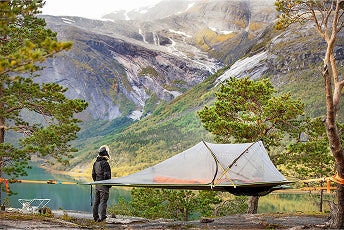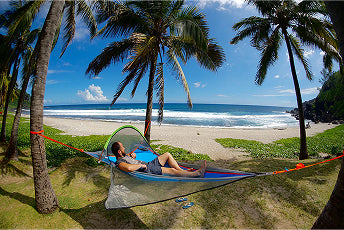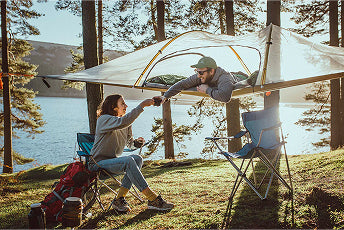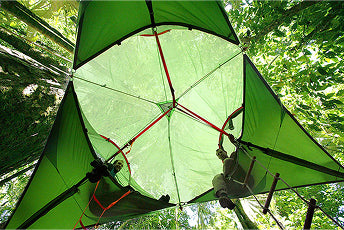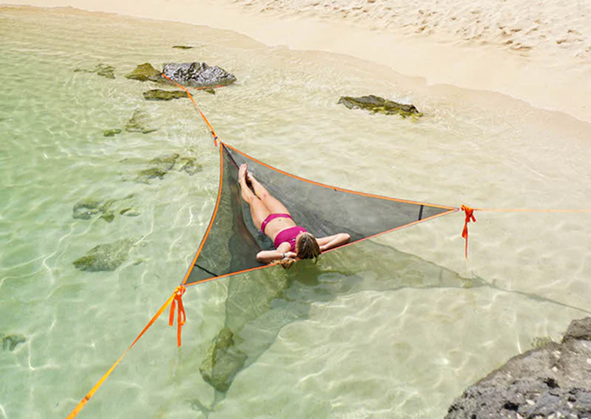Are you planning to camp in the desert or some other treeless wilderness? Or do you just want to hang out in a comfy hammock in your treeless backyard? You might be in luck—you can still enjoy a hammock for lounging or camping without trees.
Obviously, any hammock is going to need to hang from something. No, we do not recommend recruiting your Uncle Jim to be one of the posts. No matter how willing he is to offer help. You need something better. A sturdy and reliable replacement to a tree. Here are a few suggestions:
Our top 6 ways to hang a camping hammock without a tree
1. Use a Ground Conversion Kit
Whatever model of tree tent you have, there’s a Ground Conversion Kit to match. This is basically a bathtub footprint which sits under your tent allowing you to use your tree tent on the ground. You don’t need a Ground Conversion Kit to use your tent on the ground, we do recommend one, to keep the floor protected and dry. Our Ground Conversion Kits come with extendable poles to create a neat porch or entrance to your ground-adapted tent.
+ Pros
- Quick and easy set up
- Waterproof foot print
- Extendable poles create a handy entrance
- Cons
- Need a flat/stable ground surface to use
- More gear to carry
- You don't get the elevated camping experience
2. Build Your Own Wooden Posts in Concrete
 You might have an existing structure in your backyard, on the patio, or on your balcony—but more than likely you’ll need to build your own posts. Upright posts of any kind work, but you’ll need a way to attach your hammock or Tree Tent. Large, steel eye-hooks are easy to find at the hardware store and are an excellent choice (or you can wrap the posts as you would a tree).
You might have an existing structure in your backyard, on the patio, or on your balcony—but more than likely you’ll need to build your own posts. Upright posts of any kind work, but you’ll need a way to attach your hammock or Tree Tent. Large, steel eye-hooks are easy to find at the hardware store and are an excellent choice (or you can wrap the posts as you would a tree).
An excellent method for building posts in your backyard involves 10 x 10" / 25 x 25cm cut to the desired height. For your desired hammock height, remember that the posts will need to be sunk about 4-5' / 1-1.2m into the ground. Here is a diagram that you can use to help.
Begin by choosing your post spacing, keeping within the maximum of 18 feet apart. Then dig three holes about a 14" / 30cm in diameter, and 4-5' / 1-1.2m deep. Add some gravel for drainage, about 2” / 5cm in the bottom of the hole, then mix concrete (you don’t need a mixer, a good wheelbarrow or 5-gallon bucket will do), place your posts, and pour.
You’ll need to wait for the concrete mix to cure, but it is usually safe to set up the hammock and try it out in about 48-hours.
+ Pros
- Creates elevated camping experience
- Great for backyard set ups
- Fun DIY project
- Cons
- Not portable
- Only suitable for folks comfortable with DIY / construction
- Requires tear down if the structure needs to move
3. Use a Hammock stand or frame
Hammock stands are purpose made accessories, perfect for a semi-permanent hammock hanging spot. These stands or frames are often made of strong, but heavy steel. Tentsile's Backyard Tree Tent and hammock stand on the other hand, is made of lighter weight and corrosion-resistant aircraft alumin(i)um. This makes the stand easier to move around and longer lasting thanks to the lack of rust build-up from rain and moisture.
In general, hammock stands have two supporting frames that run parallel to the ground, and they can be set up anywhere that is relatively flat. Once again, Tentsile does things a bit differently, with our 3-point hammock stand, exactly what you'll need for maximum support for your Tentsile hammock or Tree Tent.
+ Pros
- Great for backyards
- Solid structure ideal for frequent use in the same spot
- Heavy duty construction
- Cons
- Not portable
- Heavy
- Cost
4. Use vehicles

If camping, your car, including its roof rack can provide a good anchor point. The roof rack may only work well if it is a reputable brand. Cheap, after-market racks may not keep your hammock (or your body) secure, so be sure to check weight limits and test it out before hooking up for the night. A car or truck with a tow hitch is the ideal option for this setup.
+ Pros
- Fun way to pitch
- Elevated camp
- Makes a great photo for Instagram!
- Cons
- Requires 3 vehicles
- You'll need a firm anchor point on your vehicle to attach to
- Can be tricky on uneven ground
5. Grab a LUNA
The LUNA is new for 2022. It's Tentsile's first ever ground tent. We taken our design experience and field tested materials to create a brand new tent designed for ground use. The LUNA has space for up to 2 people and is packed with handy features such as a sheltered porch with full floor footprint and 8000HH rainfly.
+ Pros
- Portable
- Easy to set up
- Affordable price point
- Cons
- Buying a second tent
- Doesn't work in the trees
- Not as comfy as a Tree Tent
6. Improvise

Your yard or patio may already have the means to set up a hammock. Sturdy posts, the side of the house, and other structures can work well. Often, the problem isn’t how strong the structure is, but how to attach your hammock to it. When looking for likely places to hang the hammock, corners are generally stronger anchor points than other options.
Another creative option is to hang the hammock from your deck. Or, if you have a deck that's raised off the ground a good amount (at least 4 feet), you can even hang a hammock under your deck—using the support beams as your anchor points.
Wherever you decide to hang your hammock or Tree Tent, always test out the spot you’ve chosen and make sure that if the hammock fails you don’t fall on something that could injure you. We recommend the most secure form of hammock, which happens to be the Tentsile way of doing things, with a 3-point anchor system. However you end up improvising, just remember to use plenty of common sense before climbing in. The goal is to create a relaxing spot to lounge, not a dangerous or unstable situation. Be creative but hammock responsibly!
Other Hammock Camping Tips
Finding a place to be able to hang your hammock isn’t the only thing that you need to be doing to make your adventure easier. You will need to be prepared for anything nature can throw at you.
Here are some tips to make you more prepared.
- Plan for maximum warmth – make sure you can combat any temperature
- Tarp over your hammock - protect against rainy weather
- Have a backup plan – bring a ground tent in case you can’t find a place for your hammock
- Learn to pitch the hammock & test it before you leave before you leave

